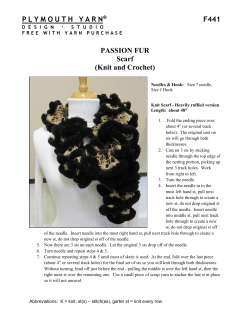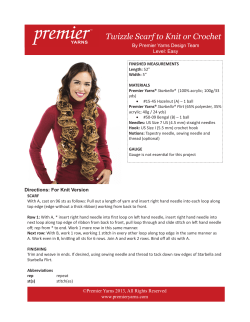
Models 7725/7725i and 9725/9725i Sample Injectors for HPLC Product Bulletin 209
® ™ Product Bulletin 209 Models 7725/7725i and 9725/9725i Sample Injectors for HPLC Rheodyne 7725/7725i and 9725/ 9725i front loading HPLC Sample Injectors are easy to use, and provide chromatographers with the Rheodyne Hallmark of Excellence... unparalleled performance and exceptional product lifetime. Figure 1. Rheodyne 7725/7725i stainless steel (left) and 9725/9725i PEEK (right) front loading sample injection valves for HPLC. A passage in the stator face assembly makes new connections before old ones break. This patented Make-Before-Break (MBB) design is an improvement over injectors which use a bypass. It is easy to troubleshoot, and does not dilute sample. MBB Flow Design for Pressure Shock Reduction Fig. 2 shows column pressure vs. time for MBB (upper curve) in comparison to non-MBB sample injectors (lower curve). As a result, a rotor seal should last for tens of thousands of injections in normal use, and shed very few particles. MBB valve 60 Non-MBB valve Pressure Rheodyne’s exclusive MBB flow architecture virtually eliminates pressure transients. The high pressure flow from the pump is uninterrupted when the injector is switched between LOAD and INJECT, a benefit when using flow sensitive detectors, fragile columns, or pumps that are disturbed by flow or pressure transients. rotor seal made of an inert polymer, and a ceramic stator face assembly. The highly-polished ceramic does not scratch or wear under normal use. pressure shock inject Time Figure 2. Rheodyne’s MBB 7725 and 9725 series sample injectors virtually eliminate pressure transients characteristic of non-MBB sample injectors. Mechanical Design The interface between the rotor and stator face is the location of the flow switching and high-pressure sealing. This interface is a flat surface, and consists of a loss of pressure (%) • Patented Make-Before-Break (MBBTM) architecture virtually eliminates transient pressure shocks for extended column life • Available in stainless steel and PEEK for sample compatibility • Zero sample loss • 2 µL internal sample loop accessory available • Wide 30° port angles for easy access • Position sensing switch built into “i” models • Small diameter internal flow paths assure minimal dispersion 40 ic am er c t ou th wi 20 0 mic cera with 0 25 50 thousands of injections Figure 3. Pressure loss of stainless steel/polymer valve (top) and Rheodyne ceramic/polymer valve (bottom) vs. thousands of injections. Page 1 of 4 2320617A 7/99 Position Sensing “i” Injectors In the 7725i and 9725i valves, turning the valve to INJECT closes a built-in position sensing switch, which remains closed until the valve is returned to LOAD. When the position sensing switch wires are attached to a chromatograph, the switch provides the system with a reproducible start signal. Zero Sample Waste A syringe needle with a flat end (square cut) must be used. When the needle is inserted into the needle port, the tip of the needle passes through a seal inside the rotor seal, and then contacts the ceramic stator face. This direct connection between the tip of the needle and the end of the loop eliminates sample holdup. All sample leaving the needle enters the loop, so there is zero sample waste. Leak Tight Needle Seal The needle seal is a Teflon sleeve that is built into the rotor seal. It grasps the tip of the needle, aligning it with the loop passage, and assures that all sample dispensed from the syringe enters the loop. The seal is under compression from an internal spring, which maintains a leak-tight, self-adjusting seal around the needle. LOAD Position When injection volumes do not often change, or when sample conservation is not required, complete filling is the method of choice. The complete fill method produces excellent volumetric precision, typically about 0.1% relative standard deviation. Sample is dispensed from a syringe, using an excess amount INJECT Position From Pump To Column Stator Stator Face Rotor Seal Syringe Needle Syringe Figure 4A. Cut-away illustrations (front view) of valve showing sample LOAD to the sample loop and sample INJECT onto the column. Drain Drain 6 1 Needle Port Connection 5 Drain Pump 4 2 Drain Pump Needle Port Connection 3 Column Column Position A (LOAD) In the LOAD position mobile phase flows to the column via port 2, a rotor passage, and port 3. The loop, which contains mobile phase trapped when the injector was returned to LOAD, can be partially or Sample Injection using Complete Filling Method Sample Loop Needle Port Fig. 4A shows a cut-away view of the valve in both the LOAD and INJECT positions. Below the cut-away view is an illustration of the internal flow passages. The six circles represent the ports in the stator. The arcs represent the connecting passages in the rotor. The needle port is shown aligned with port 4. Rheodyne front loading injection valves operate as follows: Sample is first LOADED into the sample loop by dispensing it from a syringe (Fig. 5) or by pulling it through a dip tube using a Suction Needle Adapter (Fig. 6). Sample is then INJECTED onto the column by turning the handle, which connects the loop to the high-pressure mobile phase stream. These versatile injectors offer a choice of three loading methods: Complete, Partial, and Suction. With the syringe still in the needle port the valve is turned to clockwise through 60 ° to INJECT. Channels in the rotor seal now direct the mobile phase into the end opposite from where the sample entered the loop. Note that the sample travels in a direction opposite to the direction during loading; it does not have to pass through the entire loop. The needle port and syringe now align with drain at port 5. When the needle port is flushed, the flushing solvent exits directly out this port without entering the sample loop. The needle port and syringe are never exposed to high pressure. The loop is self-cleaning, being continuously flushed by mobile phase during analysis. Sample Injection The needle port of each injector is built into the valve’s handle. When the injector is mounted on a panel, the handle and needle port are in front (Fig. 4A). In back of the panel are the body and the stator. The stator contains six tubing ports (Fig. 4B) for connecting the pump, column, sample loop, and vent lines. VERSATILE INJECTION METHODS completely filled with sample from a syringe via the needle port, which aligns with port 4. The mobile phase displaced by the sample exits the loop via drain at port 6. Position B (INJECT) Figure 4B. Illustrations of flow paths during LOAD and INJECT as viewed from the rear of the valve. Flow passages at the interface of the rotor seal and ceramic stator face are shown as grooves. The needle port connection is shown as a dark circle. MBB passages are below the plane of the interface and are not shown. Page 2 of 4 2320617A 7/99 (at least 3 times the loop volume) to displace all the mobile phase in the loop. The loop sets the volume injected; the volume is varied by changing the loop size. Since the loop sets the volume, this method does not require precise use of the syringe. Sample Injection using Partial Filling Method Applications where injection volumes change frequently, or when sample conservation is important, partial filling is the method of choice. Volumetric accuracy and precision depend on the operator’s ability to read and use the syringe, typically about 1%. The volume injected is determined by the amount dispensed into the loop by the syringe. The amount dispensed must be less than half of the total loop volume. The partial fill method does not waste sample, and allows the volume to be continuously varied without changing the loop. In partial filling (load no more than 50% of the loop volume), all of the sample dispensed from the syringe needle enters the loop, even with samples as small as 0.1 uL. There is zero sample waste. Figure 5. Sample loading by dispensing from a syringe. The sample injection valve is shown mounted to a Model 7160-010 Valve Angle Bracket. A Model 7200 2.5 µL syringe is shown. Sample Injection using Suction Method Rheodyne 9725 (PEEK) valves have no metal in contact with the flow stream. The preceeding methods expose sample to the metal needle of the syringe. Though the exposure is small, metal can be completely avoided by using a syringe to suck sample into the loop via a PEEK tube at port 6. Using this method the tube end is placed into the sample vial. An empty syringe is inserted into the needle port, and used to pull sample into the loop. Model 9125-076 Suction Needle Adapter, an accessory listed under ordering information, is recommended for the suction method. As shown in Fig. 6, the adapter makes suction loading easier. Figure 6. Sample loading by suction through a dip tube. A Model 7252 2.5 mL syringe is shown connected to the valve needle port using a Model 9125-076 Needle Port Adapter. Page 3 of 4 2320617A 7/99 Product Bulletin 209 7725 and 9725 Sample Injectors for HPLC ™ FITTINGS Consult Rheodyne Solutions Book at www.rheodyne.com for RheFlex® Fittings for your valves. SPECIFICATIONS Stainless Steel Model: 7725 and 7725i PEEK Model: 9725 and 9725i Maximum Pressure: 48 MPa (482 bar, 7000 psi) Maximum Pressure: 34 MPa (345 bar, 5000 psi) Wetted Surfaces: 316 stainless steel, alumina ceramic, and an inert polymer Wetted Surfaces: PEEK, alumina ceramic, and an inert polymer pH Range: 0-10 (pH >10, contact factory) Maximum Temperature: 80°C Flow Passage Diameters: 0.6 mm (0.024”) and 0.5 mm (0.018”) pH Range: 0-14 Maximum Temperature: 50°C Flow Passage Diameters: 0.3 mm (0.013”) and 0.5 mm (0.018”) Supplied: 20 µL sample loop, RheFlex fitting set for all ports, hex keys, needle port cleaner, mounting screws, and vent tubes. ORDERING INFORMATION Stainless Steel Injection Valves Part Number 7725 7725i Description Sample Injector Sample Injector with position sensing switch Use only genuine Rheodyne fittings Stainless Steel Sample Loops for Stainless Steel Valves Part Number Description 7755-015 2 µL 7755-020 5 µL 7755-021 10 µL 7755-022 20 µL 7755-023 50 µL 7755-024 100 µL 7755-025 200 µL 7755-026 500 µL 7755-027 1 mL 7755-028 2 mL 7755-029 5 mL RheBuild™ Kits RheBuild Kits are available for all Rheodyne valves. Each kit includes all parts, tools, and instructions to maintain precision performance. PEEK Injection Valves Part Number 9725 9725i Description Sample Injector Sample Injector with position sensing switch Use only genuine Rheodyne fittings PEEK Sample Loops for PEEK Valves Part Number Description 7755-015 2 µL 9055-020 5 µL 9055-021 10 µL 9055-022 20 µL 9055-023 50 µL 9055-024 100 µL 9055-025 200 µL 9055-026 500 µL 9055-027 1 mL 9055-028 2 mL 9055-029 5 mL 9055-033 10 mL RheBuild Kits and Accessories Part Number Description RheBuild Kits 7725-999 for Models 7725/7725i 9725-999 for Models 9725/9725i Accessories 9125-076 Suction Needle Adapter 7160-010 Valve Angle Bracket 7160 Mounting Panel 7160-029 Ring Stand Bracket Assembly ® Page 4 of 4 2320617A 7/99 PO BOX 1909 • ROHNERT PARK, CA 94927-1909, USA • 707-588-2000 • FAX 707-588-2020 www.rheodyne.com
© Copyright 2025










